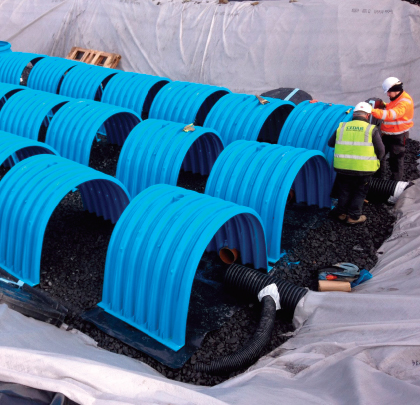Contractors are used to confronting construction challenges. They pop up in various forms—a delay in receiving supplies, weather, regulations, scheduling, lack of communication—and those challenges can cause costly delays and throw the entire plan off course. Most contractors work around the delays professionally and finish the project on time.
Imagine the anxiety for contractors in Ireland working on 14 projects simultaneously. Fourteen buildings, 14 plans, 14 sets of challenges that could frustrate workers in the construction of new primary healthcare centers. Among the challenges was designing different systems for stormwater management. Crews faced different ground and soil conditions, project scopes, weather issues, workspace footprints, and more while building the new health centers.
“There were a lot of different things that we had to work around,’’ says David Newman, a stormwater attenuation specialist for Sustainable Environmental Water and Energy Solutions (SEWES) in Ireland. “Each project came with its own set of challenges.”
An American company, Connecticut-based CULTEC, helped Newman and his crews solve the stormwater management issues. In four of the largest projects—in Ballymote, Westport, Tuam, and Waterford City—Newman recommended high-capacity chambers to manage the water. Smaller centers used crate systems or in-situ tanks to manage the runoff. “We had to work extensively to find out which system would work best in each area,’’ Newman says. “We had some shallow systems that required smaller chambers and a wide range of ground conditions. It was a complicated process.”
MEETING CHALLENGES
Balfour Beatty and J.J. Rhatigan of Ireland started building the primary care centers in late 2016. Some have been completed, while others will be completed in 2018. Each project, however, required its own system for stormwater management. Newman says his engineers and construction teams had to be flexible and creative in solving issues at each worksite.
“The initial designs for the systems were planned within a specific footprint,’’ Newman says. “But because some of the drainage areas were 30 and 40 years old, the systems had to be remodeled and reconfigured. In many cases, workers encountered rock that they did not know about. There were initial surveys done, but accuracy is never 100 percent.”
Newman’s teams redesigned projects as they encountered different ground conditions, soils, and drainage levels once they started digging into the earth. “We had to work with the various soils differently,’’ Newman adds. “The thing about CULTEC’s plastic chambers is they cater to different ground conditions and water levels, so they can be used in a lot of different settings.”
Along with the different soil properties, workers faced additional challenges. Since many of the projects were constructed in urban areas, Newman and his teams worked in a tight footprint. “We didn’t have a lot of extra space where we could store equipment,’’ Newman says. “The chambers are stackable, which made it easy to keep the footprint tight.”
Crews installing stormwater management chambers also faced weather delays. Newman says his teams started installing chambers in December 2016 and encountered weather difficulties for the next few months. Workers needed a certain time frame to excavate the area and keep it dry until they got the chambers in place.

CULTEC’s plastic chambers cater to different ground conditions and water levels, so they can be used in a lot of different settings.
GOING BIG IN A SMALL FOOTPRINT
Newman says crews used CULTEC’s Recharger® 902HD™ high-capacity chambers in the projects. The chambers offer the advantage of minimizing project costs by maximizing storage volume in a specific footprint. In all, Balfour Beatty and J.J. Rhatigan used 352 chambers at the four primary care centers.
The CULTEC chamber has a storage capacity of 17.66 ft³/ft. “The chamber from CULTEC allowed for a deeper tank and reduced the overall footprint,’’ Newman adds. The scope of the project varied at each site. In Waterford City, for instance, Newman’s teams constructed two beds. The first consisted of 104 chambers, while the second required 68. The system was constructed in footprints that extended to 38×7.5 meters and 29×11 meters. The chambers managed 481 and 281 cubic meters of stormwater runoff respectively.
The Ballymote system included 75 chambers in a footprint of 26×8 meters. The Westport system consisted of 54 chambers in a 9.5×21 meter land area, and the Tuam system required 51 chambers in a 19×8 meter footprint.
The Recharger 902HD stands 1,219 millimeters tall and measures 1.25 meters long and 1,981 millimeters wide. The Recharger 902HD provides resistance to loads and load factors as defined in AASHTO LRFD Bridge Design Specifications Section 12.
LONG TIME COMING
Ireland’s then-Minister for Public Expenditure and Reform, Brendan Howlin, announced in July 2012 the government’s intention to build 14 primary care centers to help address the nation’s health needs. The facilities were constructed as part of a Public Private Partnership (P3) and included design, building, financing, and maintenance along with facility management services. The European Fund for Strategic Investments provided funding for the project.
As Ireland improves its health infrastructure, more families will have better access to contemporary health care. “Our client is very happy,’’ Newman says. “We performed what we said we were going to do. The primary care centers are now brand spanking new, and residents are very pleased with what they have in their communities.”
About the author:
Gina Carolan is the chief operating officer and director of marketing for CULTEC, Inc., a family owned and operated company with experience in the drainage industry dating back to the 1950s, and the manufacturer of the Contactor® and Recharger® Plastic Septic and Stormwater Chambers. For more information, visit www.cultec.com.
_________________________________________________________________________
Modern Contractor Solutions, May 2018
Did you enjoy this article?
Subscribe to the FREE Digital Edition of Modern Contractor Solutions magazine.



